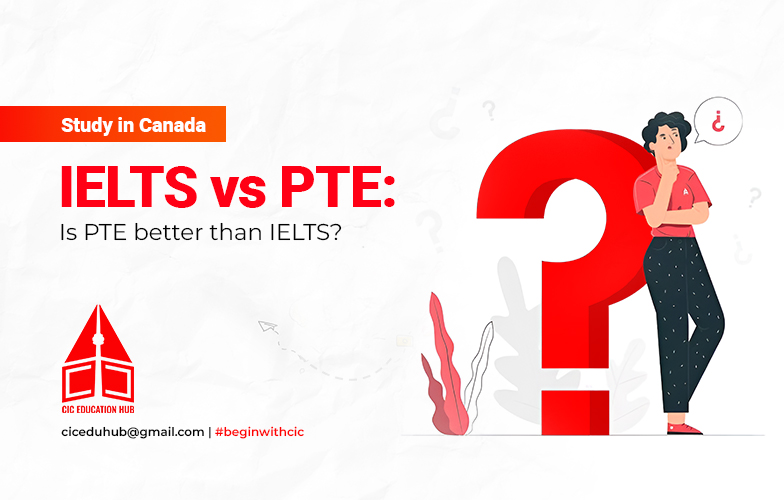IELTS vs PTE: Is PTE better than IELTS?

If you’re thinking about studying in Canada, it’s important to be good at English. There are two popular exams, IELTS and PTE, that assess your English proficiency. These tests evaluate your language skills, and knowing their unique aspects can really help you get ready. By learning more about these exams, students from Nepal can choose the one that suits them best.
Are you worried about choosing the test? Don’t worry. CIC Education Hub is your guidance partner to international journey. This blog will help you decide between PTE and IELTS by thoroughly examining various aspects, explaining how they’re conducted, comparing IELTS VS PTE.
Summary on IELTS VS PTE:
IELTS:
IELTS, which stands for the International English Language Testing System, is a test for people who speak English as a second language. The purpose of this test is to evaluate how well someone can understand and use English. It checks skills in listening, reading, writing, and speaking. These skills are crucial for academic or professional reasons, especially if you want to study or work in countries where English is the main language.
PTE:
PTE, which stands for Pearson Test of English, is a well-known is a well-known English language test. It looks at listening, reading, speaking, and writing skills. PTE is liked because it’s done on a computer, giving results fast. The test has different types of questions to check many language skills. Many universities and places around the world accept PTE scores. People take PTE to show they’re good at English for school or moving to a new country. People like it because it’s easy to take, scores are quick, and many places recognize it.
IELTS VS PTE Exam Score:
Taking the PTE or IELTS exams in Nepal may have different prices based on where you take them. Here’s an estimate:
PTE:
It usually costs between NPR 22,000 to NPR 25,000 in Nepal, which is around USD 160 to USD 190.
IELTS:
The IELTS exam price in Nepal is approximately NPR 21,000 to NPR 23,000, which is about USD 180 to USD 190.
Exam Structure:
IELTS:
The IELTS exam typically spans 2 hours and 45 minutes. The Listening, Reading, and Writing sections are conducted consecutively, while the Speaking section may be taken on the same day or up to a week before or after the other modules.
IELTS exam is divided into four parts:
Listening (30 minutes)
Reading (60 minutes)
Writing (60 minutes)
Speaking (11-14 minutes)
PTE:
PTE Academic is a three-hour test where all sections are conducted in a single sitting. The test-taker navigates through a variety of tasks, each designed to assess specific language skills. The computerized format ensures a seamless and efficient examination process.
PTE exam is divided into three parts:
Speaking and Writing (77-93 minutes)
Reading (32-41 minutes)
Listening (45-57 minutes)
IELTS PTE VS Tasks:
IELTS:
The IELTS tasks vary across sections, testing different language skills. The Speaking section involves a face-to-face interview, while the Writing section assesses one’s ability to express ideas coherently and accurately.
PTE:
PTE tasks include speaking into a microphone, writing essays, summarizing information, and responding to questions based on audio and written passages. The test’s dynamic nature ensures a comprehensive evaluation of various language competencies.
Which is Better: IELTS VS PTE?
Deciding between IELTS and PTE depends on what you like and are good at. Some say PTE is fairer because it is based test and gives quick result within 2-3 days. Others prefer IELTS because it’s more traditional, especially in speaking, where talking to a person is seen as important and usually results are available within 13 days (about 2 weeks).
Is PTE Easier than IELTS?
Different people find different tests easy or hard. PTE might be easier for some because it’s on a computer, while others might like the traditional IELTS. It’s a good idea to practice both to see which one you like and are good at.
IELTS VS PTE Eligibility Criteria:
IELTS Eligibility Criteria:
Age: There is no specific age limit for IELTS, yet individuals under 16 might need to provide additional documents.
Education: No educational qualifications are needed to take the IELTS test.
ID: Test-takers must furnish a valid passport or national identity card for identity verification.
English Proficiency Level: IELTS accommodates candidates at all proficiency levels, from beginners to advanced.
PTE Eligibility Criteria:
Age: Test-takers under 18 require written consent from a parent or guardian.
Education: Like IELTS, no specific educational qualifications are necessary for the PTE test.
ID: A valid passport serves as proof of identity for PTE test-takers.
English Proficiency Level: PTE caters to candidates across all proficiency levels, from novice to advanced.
Advantages and Disadvantage of IELTS VS PTE:
PTE Advantages:
- Quick Results: You get your results fast, usually within 2-3 days, as it’s a computer-based test.
- Fair Scoring: The test uses computer algorithms to score, reducing the chance of bias in evaluation.
- Flexible Scheduling: You can choose from various test dates and times throughout the year, making it convenient for busy schedules.
PTE Disadvantages:
- Limited Acceptance: In some countries, PTE might not be as widely accepted as IELTS, especially for immigration or academic admissions.
- Fixed Test Format: You can’t go back to previous questions or sections during the test, which can be challenging for some.
- Fewer Preparation Resources: Compared to IELTS, there might be fewer study materials available for PTE, making it harder to prepare adequately.
IELTS Advantages:
- Global Recognition: Many organizations worldwide accept IELTS, making it a versatile choice.
- Test Format Options: You can take IELTS on a computer or on paper, giving you flexibility based on your preference.
- Flexible Time Management: You can skip questions and go back to them, helping you manage your time effectively during the test.
IELTS Disadvantages:
- Result Turnaround Time: It takes about 13 days to get IELTS results, which might be too long for those who want feedback quickly.
- Human Examiners: IELTS scoring involves people, which could introduce subjectivity or bias.
- Limited Test Dates: In some places, there aren’t many options for when you can take the IELTS test, making it harder to schedule at your preferred time.
Read More: Benefits to study in Canada from Nepal
Conclusion:
In short, when deciding between IELTS and PTE, it depends on what you like and how you perform best. IELTS is known for its world wide acceptance, while PTE is more modern and provides faster results. If you you are searching for best educational guidance, CIC Education Hub is here for you. The choice comes down to your strengths, whether you’re comfortable with a computer or prefer pen-and-paper. Both tests are reliable for showcasing your English skills, offering opportunities for academic or professional purposes.
FAQ’s :
Which test is more commonly accepted in Canada?
Both IELTS and PTE are accepted by Canadian immigration authorities. It depends on the specific immigration program or institution you are applying to.
Is one test easier than the other?
The level of difficulty in these tests can differ from individual to individual, as it is subjective. For some, the IELTS may seem more manageable due to its specific format, while others might find the PTE more favorable because of its computer-based structure.
How are the scoring systems different?
IELTS has a test score ranging from 0 to 9, while PTE uses a scale of 10 to 90. Both tests assess four language skills: listening, reading, writing, and speaking.
Are there any differences in test formats?
Yes, IELTS includes face-to-face speaking interviews, while PTE has a fully computerized speaking section.
Which test provides faster results?
PTE generally provides quicker results, usually within 5 business days, while IELTS results may take up to 13 days.
Can I retake the test if I’m not satisfied with my scores?
Yes, both IELTS and PTE allow test-takers to retake the exams to improve their scores. Be aware of the waiting periods between test attempts.
Can I use old scores for Express Entry if they are still valid?
Yes, as long as your scores are within the two-year validity period, you can use them for Express Entry.


